Gea Elika's Blog, page 173
March 24, 2015
210 West 77th
With a total of 25 units spread out over 18 floors, this wonderfully designed building is located right in the heart of the Upper West Side. Thanks to its extremely desirable location and spacious residences, 210 West 77th is a great place to call home.
Architecture
As a new construction building, this site gave Thomas Juul-Hansen an opportunity to execute on a complete vision. Upon seeing the building for the first time, the warmth of its Danish Modernism is immediately apparent. Throughout the building’s exterior and interior, the influence of natural materials can be seen. Whether it’s the custom hand-formed brick facade or the stepped terraces, this building looks wonderful in its Upper West Side location.

Residences

When you walk into one of the living rooms of a residence located on floors 4 through 12, you’re immediately greeted with tall ceilings that are accented by lots of natural light. As you move through the space, Juul-Hansen’s emphasis on natural materials creates an atmosphere that is truly beautiful.

Not only does the kitchen look amazing, but it provides all the functionality needed to prepare excellent meals. And once you enter the master bedroom and spacious master bathroom, you’re immediately put into a space that delivers complete relaxation.

Amenities
The first notable amenity of 210 West 77th is its private spa. Thanks to two private marble steam rooms and a cedar lined sauna, it’s the perfect place to relax. If you’re looking for a different way to work up a sweat, you’ll have no trouble doing so in the state of the art fitness center.

Since this building has such a desirable location, the roof deck provides the ideal space to enjoy all of the surrounding views. 210 West 77th also has a concierge and doorman. The building has a bike room, as well as available parking and storage.

Availability
Seven of the building’s units are currently listed. The residences range in size from three to five bedrooms. Three of the available units are:
A 3 bedroom, 3.5 bathroom with 2,082 square feet of space for $4.975M
A 4 bedroom, 4.5 bathroom with 2,720 square feet of space for $6.45M
A 5 bedroom, 4.5 bathroom with 3,519 square feet of space* for $12M
*includes 1,283 square feet of exterior space
Neighborhood
Because 210 West 77th is located in the Upper West Side, it provides convenient access to everything that makes New York City such a great place to call home. Numerous coffee, bakery and dining options are nearby. There are plenty of grocers and markets, as well as access to all types of shopping. And thanks to the availability of great schools and lots of cultural attractions, 210 West 77th is a great choice for new or growing families.
[ 210 West 74th ]
The post 210 West 77th appeared first on | Elika Real Estate.
March 22, 2015
The Condo Life: 6 Luxury Conversions to Consider
Condo buyers with big budgets won’t have an issue finding a home in New York City in the near future. Newly constructed condo buildings continue to surface in Manhattan and Brooklyn, and conversions are on the rise. More potential NYC homeowners are in the market for condos since many boast long lists of amenities, flexible financing options, and more lenient subletting rules than co-ops.
These condominium conversions offer luxurious benefits such as large outdoor spaces with pools, playrooms, and convenient locations in enviable sections of town, not to mention superb interior detailing.
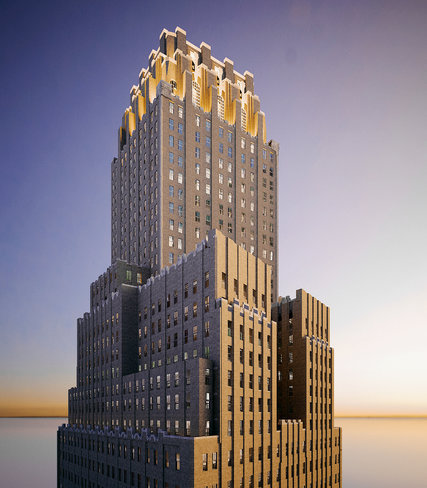
Considered to be the first Art Deco skyscraper, the 32-story “Ralph Walker TriBeCa” will offer 161 units ranging from one to five bedrooms, smack dab in the heart of downtown Manhattan. Built in 1927, the conversion will feature more than 40,000 square feet of indoor and outdoor amenity space, as well as a fitness center with yoga and Pilates, a heated lap pool, and a spa treatment room. Prices are $2,000-plus per square foot.
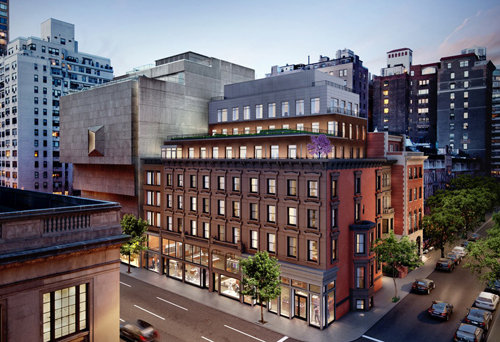
Offering residents the ideal balance between historic interiors and a modern lifestyle, the Upper East Side project boasts ten residences, with only a few currently available. Designed by Alexandra Champalimaud and Beyer Blinder Belle, 33 East 74th embraces the elegance of the neighborhood and exquisite architectural nuances. Built in 1910, the condo building is pricey. Units start in the 5,000 per square foot range.
The Astor
With both Central Park and Riverside Park close by, the Upper West Side is one of the most desirable neighborhoods. But believe it or not, condominium buildings (new or converted) aren’t as prevalent as they are in some other areas of town. Enter the Astor at 235 West 75th on the corner of Broadway. The 212-unit building will convert to 100 apartments in 2015, and homes are expected to start around $1.1 million, which is still fairly affordable by New York City standards.

Located at 177 Montague on the edge of Brooklyn Heights and Downtown Brooklyn, the Brooklyn Trust Company’s upper floors are slated to become 12 condo residences. Built in 1916 and designed to resemble an Italian Palazzo, the landmark building’s prices will start higher than $3 million, which is on the high side for Brooklyn. Amenities in the plan include a music room, fitness center, rooftop deck, and even a dog spa for Fido. At this point, the Chase bank on the ground floor will remain.
325 W Broadway
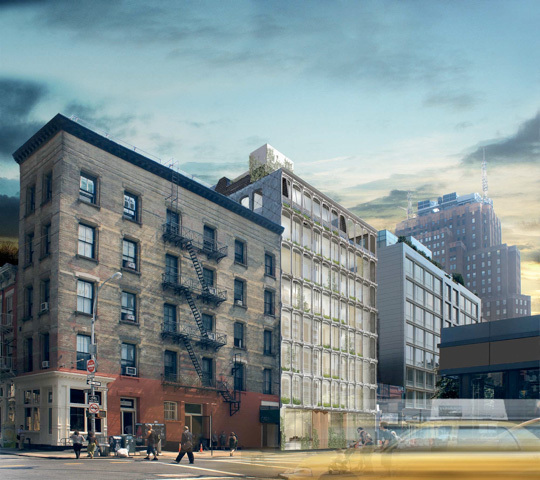
Supposedly hitting the market late spring, the conversion of “The Chocolate Factory” in SoHo has been in the works since 2008. Spacious layouts, a courtyard and gym, not to mention one of Manhattan’s coveted neighborhoods outside your door, are just a handful of reasons to live in one of the 21 units at 325 West Broadway.
Bow Building
For those looking for a boutique condo, the Bow Building at 242 Fifth Avenue between 27th and 28th Streets in the No-Mad district just might be a viable option for your new pad. Expect sales of the four-unit building with private outdoor spaces to launch this summer. Rumor has it that prices will start in the $3.5 million range.
The post The Condo Life: 6 Luxury Conversions to Consider appeared first on | Elika Real Estate.
March 21, 2015
How the New York City Real Estate Transfer Tax Affects Buying & Selling
As anyone who has gone through this process will tell you, buying or selling real estate in New York City is a different experience from just about anywhere else in the world. Although buying and selling real estate may seem like something that would be consistent regardless of location, factors like the nature of the New York market make it a unique experience.
One factor that causes this market to be different from many others is the New York City real estate transfer tax. Since it’s common for people to be unaware of this specific tax until the time comes to pay it, we thought it would be helpful to provide answers to some of the most common questions that come up about it:

When do you need to pay this tax?
The New York City real estate transfer tax, which is often referred to as the Real Property Transfer Tax, applies to sales, grants, assignments, transfers or surrenders of real property in NYC. This tax is also applicable if you own at least 50% of an entity like a corporation that owns property as well and decide to sell the entity.
Is there a threshold for this tax?
Yes, the New York City real estate transfer tax applies to sales or transfers that are for at least $25,000.
Are there exemptions from the New York City real estate transfer tax?
While the United States government and its agencies, New York state and its agencies, and foreign governments are exempt from the tax, exemptions aren’t available for individuals or private companies. Even in the event of someone purchasing property from a government entity, the non-government individual or company is still responsible for paying this tax.
How do you apply for this tax?
If you end up in a situation that requires you to pay the New York City real estate transfer tax, there are two ways to submit your application. In addition to applying in person, the official website of the city of New York makes it possible to apply online.
What’s the best way to prepare for the impact of this tax and other unique factors?
Since the New York City real estate transfer tax is just one example of the unique factors that impact buyers and sellers in this market, it’s easy to understand why buyers often begin to feel overwhelmed. That’s especially true for buyers who are going through this process for the first time.
If you’re thinking about buying property in New York but are worried about encountering unforeseen challenges, the best step you can take is educating yourself about the intricacies of the New York City real estate market. Because we’ve seen firsthand how many obstacles buyers need to tackle, we decided to publish the Home Buyers Handbook.
By downloading the Home Buyers Handbook and taking time to read through all of it, you will be able to learn about all of the different factors that will impact your search for the ideal home in the world’s most competitive real estate market.
The post How the New York City Real Estate Transfer Tax Affects Buying & Selling appeared first on | Elika Real Estate.
March 20, 2015
Why Do New York City Apartments for Rent Cost So Much?
Making the decision to move to New York City can be the start of a very exciting experience. While NYC has a lot to offer to the people who make it their home, it’s important to understand the realities of living in the most populated city in America.
For many people, the decision to move to NYC comes as a result of a job offer. One reason that taking a job in this city can seem like such a great opportunity is because salaries are often higher than they are in other parts of the US. Although that may initially make you feel like you’re going to have a lot of extra money in your bank account, your outlook will likely change once you start digging into the cost of New York City Apartments for rent.

4 Reasons Why New York City Apartments for Rent Are So Expensive
When you start seeing the high prices for apartments that would be considered small in other parts of the country, one of the first thoughts that may come to mind is why exactly are NYC apartments so expensive? As with most questions related to financial matters, there’s not just one factor at play. Instead, the high prices of New York City apartments for rent are the result of several factors. Those factors include:

Limited Space & Zoning Rules: Over nine million people live in NYC. Since everyone needs a place to live, there’s definitely not a surplus of available apartments. Add to that the fact that zoning rules prohibit much of the city from becoming denser, and it’s easy to see why the prices of the limited supply of apartments get driven up.
The Impact of Rent Control: When you hear about an extremely cheap apartment in New York City, chances are it’s either rent controlled or a scam. Because people in rent controlled apartments often stay there until they pass away, the price of apartments that are actually available for rent gets driven much higher than the median rent across all of New York. While the impact of rent regulated apartments aren’t as big of a factor, they do still factor into this equation.
High Property Taxes: Other than Detroit, where property values have plummeted, New York has the highest property taxes in all of the US. While renters don’t directly pay taxes on where they live, this high tax rate does get passed to them in the form of higher rents.
Favorable Tenant Laws: Because New York’s laws make it very difficult to evict tenants, landlords are often very strict about credit requirements. It’s also common for landlords to charge the state’s legal maximum of a full month’s rent as a deposit.
Despite New York’s high rents, apartments that hit the market generally get snapped up very fast. Since the city has such a competitive rental market, even renters with a healthy budget can feel overwhelmed. If you’re currently in this position, find out how Elika renter’s representation can help you start your new life in NYC in a great apartment.
The post Why Do New York City Apartments for Rent Cost So Much? appeared first on | Elika Real Estate.
March 19, 2015
New York City Real Estate Records: How to Find Useful Information
Because all of the property sales that take place in New York City are part of public record, anyone can look up information for a specific property. Whether it’s a buyer who wants to learn more about their next potential home or a seller who wants to price their home based on nearby comps, New York City real estate records can provide a lot of useful information.
While NYC real estate records can be useful to people in different situations, that doesn’t mean accessing them is easy. The reason that actually pinpointing the information you want can be a challenge is because it involves going through ACRIS.
Calling ACRIS, which stands for the Automated City Register Information System, a “legacy” database and interface is putting things nicely. For most, pulling up this website instantly leads to unpleasant feelings. Since it’s unlikely that this system will become easier to use anytime soon, we want to provide a walk-through on the best way to use it.
How to Use ACRIS Without Pulling Your Hair Out

If you have a specific property in mind and the only reason you need to use ACRIS is to find its past sale & mortgage info, the good news is this is the most straightforward use of the system. On the Main Options page, click the Find Addresses and Parcels link. From there, you can enter the address you want to look up. Keep in mind that if the property is not a townhouse, you may need to try a couple of guesses to figure out the right unit number to use for the ACRIS search.

If you need to browse ACRIS instead of performing a direct search, Search Property Records is the link you’ll want to click on the Main Options page. From there, you can narrow your search by different types of documents. Once you’ve selected a document option like Deeds and Other Conveyances, you can experiment with the date range and borough/county parameters to get a selection that yields the results you’re interested in viewing.
Two Simpler Alternatives to ACRIS
Now that we’ve gone through the key steps, you will likely feel more confident using ACRIS. However, that doesn’t mean the process will be any more enjoyable. If you want an easier way to access New York City real estate records, the first alternative is to utilize the website StreetEasy. Even though its listings may not have as much information as ACRIS, it’s often possible to find the main information you want. And since searching StreetEasy is very simple, it’s worth taking a couple of minutes to try.
If you like the idea of an easier interface but still feel like you have too much on your plate to spend time digging for New York City real estate records, the other alternative is working with an experienced buyer’s agent. Not having to worry about coming up with this information on your own is just one of the many benefits that a buyer’s agent can offer during your search for a luxury home in NYC.
The post New York City Real Estate Records: How to Find Useful Information appeared first on | Elika Real Estate.
March 18, 2015
New York City Apartments for Sale – What to Expect During 2015
If you’ve been spending time looking at New York City apartments for sale because you’ve decided that you want to buy one, it’s very helpful to know the current state of the Manhattan market. And the best way to get a handle on the current market is to look at its condition during the last quarter of 2014.
Key NY Real Estate Market Numbers from Q4 of 2014
According to REBNY market research, the median price per square foot for Manhattan apartment sales was $1,331 during the last quarter of 2014. The more significant number was the average price per square foot of Manhattan condo sales. The fourth quarter figure of $2,338 marked a 37% increase from the fourth quarter of 2013.
The large average price increase in condo sales can be partially attributed to closings at 157 West 57th Street. This location saw a total of nine sales in the $20+ million range. It’s also worth noting that the average sale price of a home in NYC increased 11% to $841,000. Previously, the average sale price of a NYC home during Q4 of 2013 was $760,000.
The Impact of Luxury Condos and New Apartments
Luxury condos were one of the trends that had a significant impact on shaping 2014 and the current market of New York City apartments for sale. Specifically, the number of sales for condos with a listing price of at least $10 million increased by 191% from 2013.
While projections point towards 6,500 new apartments coming to the market in 2015, that doesn’t mean this will provide price relief. Because the bulk of this inventory will lack price diversity, the competition for inventory will continue. That’s especially true for one and two-bedroom apartments, which were the types of apartments that were fastest to go into contract in 2014.

As a result of all of these factors, most people agree that 2015 will continue to be a seller’s market. Although the current state of the market definitely presents some challenges to buyers who are looking at New York City apartments for sale, that doesn’t mean that finding the right apartment is going to turn out to be mission impossible.
The best way to give yourself an edge in this competitive market is to work with a buyers agent. Because Elika is the only exclusive buyers agent in Manhattan that is eligible for membership in the National Association of Exclusive Buyer Agents, you can count on our experienced team to help you find the ideal apartment to call home.
Working with a buyers agent means you’ll have access to unbiased expert knowledge and services. This will directly translate into you saving time and money. Since working with a buyers agent also means you’ll reap other benefits like having someone to negotiate for you, be sure to read more about what you’ll gain from working with a buyers agent.
The post New York City Apartments for Sale – What to Expect During 2015 appeared first on | Elika Real Estate.
March 17, 2015
Spring Clean: A Checklist to Whip Your Apartment into Shape
After another brutal winter, New Yorkers are thrilled with the start of spring weather and the official first day on March 20. With milder temperatures, chirping robins, and blooming buds (hopefully) headed our way, there’s no time like the present to schedule an annual spring-cleaning.
I’m not fond of cleaning (is anyone?), but I’m extremely fond of the results when I’m finished. So I say, keep your eyes on the prize as you start purging, scouring, and sweeping, knowing that the hours of hard work will be worth the time and trouble.

Contemporary Living Room by Melbourne Interior Designers & Decorators Nexus Designs
Before you get started, however, be sure to have all the necessary cleaning products, as well as rags, paper towels, scrub brushes, and a good vacuum.
Here’s a checklist of the must-dos during an apartment spring-cleaning. To get the job done right, I recommend spreading these tasks over at least a few days, or possibly two weekends.
Contemporary Kitchen by New York Cabinets & Cabinetry LEICHT New York / LEICHT Westchester
Get organized. Be sure to do the de-cluttering before the cleaning begins. Get each belonging in its place, and if your things are out of order, find each item a home.
Wipe all surfaces, and be sure to remove those items that you often “wipe around” when you’re in a rush or get lazy. Use the appropriate cleaning product for each surface (wood, glass, stone, etc.)
Clean your windowsills, first with a vacuum, and then with a damp cloth and cleaner as needed.
Wash the inside of your windows and the outside if you can. If you can’t reach the outside, you might be able to get your super to help, or you might need to hire a pro instead.
Vacuum window treatments with a brush attachment.
Use the brush on your vacuum on lampshades, vents, blinds, baseboards, moldings, door headers, and light fixtures including the blades on ceiling fans. After vacuuming, wipe down with a damp cloth.
Clean digital screens (computers and television) with a screen cleaner like Monster Flatscreen Cleaner and a soft cloth.
Wash all bedding including mattress covers. Flip mattresses.
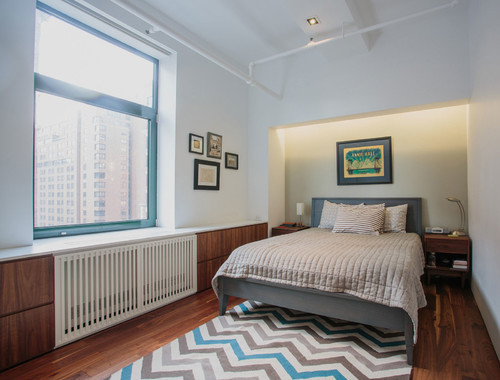
Contemporary Bedroom by New York Architects & Building Designers Raad Studio
Vacuum upholstery, cushions, under the cushions, as well as throw pillows.
Wipe all stainless steel surfaces in your kitchen, as well as the faucet and sink (if metal) with a stainless steel cleaner.
Clean out the fridge. This isn’t fun, but it is a must! Remove all items and discard any expired foods or condiments. Windex each glass shelf. Wipe down the door compartments and crispers.
Run the grates on your stovetop through the dishwasher or scrub by hand. To clean your oven, make a paste of water and baking soda, which does a dynamite job. Note: This method doesn’t work if you store sweaters in your oven like Carrie Bradshaw.
Every New York City apartment has a microwave. Just scrub it until it’s clean. Windex works well here.
Now on to the bathroom. Use a cleaner like Bon Ami and some good old-fashioned bleach and a brush to scrub your toilet bowl, sink, and tub. Pull out the stainless/metal cleaner and use it on the faucets and showerhead.
Use a gentle cleanser like Bon Ami or Comet and a brush in your shower, toilet and bathroom sink. Bleach toilet as needed.
Wash fabric shower curtains and replace vinyl curtains and liners. If you have a shower door, now’s the time to give it a good scrub with shower cleaner. Don’t forget to do the same with the tile in your surround.

Eclectic Bathroom by New York Interior Designers & Decorators moment design + productions, llc
Dry mop or Swiffer hardwood or parquet floors.
Vacuum all area rugs/wall-to-wall carpeting.
Wet mop or Swiffer all hardwood/tile floors.
Replace smoke/carbon monoxide detector batteries. Be sure to test.
Did you forget anything? Yes, you did –– you almost forgot to sit back with a nice glass of wine, your favorite brew, or a cocktail in your sparkling clean apartment. You deserve it!
The post Spring Clean: A Checklist to Whip Your Apartment into Shape appeared first on | Elika Real Estate.
What Are the Grounds for Eviction of Rent Controlled or Stabilized Tenants in New York?
There are many online articles that list the best states in the US for landlords. While states like Texas and Arizona almost always make these Top 10 lists, one state that you won’t ever see listed is New York.
The reason New York isn’t considered a landlord friendly state is because there are multiple laws in place that provide tenants with numerous rights. In fact, there are countless examples of it taking 6+ months or even years to evict a tenant who has stopped paying rent.
Since there are numerous legal issues that can affect both tenants and landlords, one common area of interest is in regards to eviction of tenants who are in a rent controlled or rent stabilized unit. Because many people are interested in learning more about this issue, we thought it would be helpful to cover it in detail.

Understanding the Basics of Rent Controlled and Rent Stabilized Units
Before we can fully explore the grounds for eviction of rent controlled or rent stabilized tenants, it’s helpful to understand exactly what these terms mean. While both involve rent regulation, the specific regulations are different.
Although it seems like rent controlled apartments get the most media attention, rent stabilized apartments are actually far more common. According to data from the 2011 NYC Housing and Vacancy Survey, there were around 1 million rent stabilized apartments. In comparison, there were less than 40,000 rent controlled apartments in New York City.
In order for an apartment to be rent controlled, it must be in a building that was built prior to February of 1947. The other main criteria for rent controlled apartments is that the tenant or a tenant’s lawful successor has to have been continuously living in the apartment since July 1st of 1971. It’s worth noting that in the case of an apartment that’s located in a one or two family home, continuous occupancy must go all the way back to April 1st of 1953.
The definition of a rent stabilized unit is one that’s in a building with at least six units and was built between 2/1/47 and 1/1/74. In some cases, rent stabilized apartments can be found in post-1974 buildings as a result of special tax benefits. Rent stabilization can also occur when a previously rent controlled apartment becomes vacant.
While rent stabilization has had numerous effects since it was instituted in 1969, the two main objectives of this program are to prevent sharp rent increases and to provide tenants with the right to renew their leases.
How Does Rent Control and Stabilization Affect Evictions?
Now that we’ve covered both rent control and rent stabilization, it’s time to take a look at how these issues impact evictions. In the state of New York, an eviction requires going through a court proceeding and obtaining a judgment of possession. If this judgment is granted by the court, the eviction can be carried out by a constable, marshal or sheriff.

With regards to rent control and stabilization evictions, there are situations where DHCR approval must be granted prior to taking the eviction to court. However, there are six different scenarios in which a landlord can begin the eviction proceedings without needing to seek DHCR approval. Those scenarios are:
Non-payment of rent
Failure to cure a violation of a substantial obligation of the tenancy
Damaging the housing accommodation
Refusing the owner access to make needed repairs
Occupancy of the housing accommodation by the tenant is illegal because of the requirements of law, and the landlord is subject to civil or criminal penalties therefore, or both
The tenant is using or permitting such housing accommodation to be used for an immoral or illegal purpose
There are also three scenarios in which a landlord can refuse to renew a lease for a rent controlled or stabilized apartment without needing to get DHCR approval. Those scenarios are:
Occupancy by the owner or member of the owner’s immediate family member for personal use
Recovery of the unit by a not for profit institution for use in connection with its charitable or educational purposes
The tenant is not using the unit as a primary residence
To clarify, these scenarios do not guarantee that a landlord will be successful in evicting a tenant or being able to not renew their lease. All it means is that court proceedings can be brought forward without first needing to go through DHCR.
In terms of situations that always require DHCR approval, the four worth noting are:
Withdrawal from the rental market
Demolition
The elimination of unsafe housing to either rehabilitate or demolish it pursuant to state or federal laws
Conversion to cooperative or condominium ownership
As previously mentioned, rent control or stabilized tenants are protected from arbitrary rent increases by landlords. These tenants also have the right to renewal leases. And in the case of tenants who are senior citizens (at least 62) or disabled, they cannot be evicted on the grounds of owner occupancy.

Taking Over a Lease and Deregulation
In the case of a tenant passing away, protection from eviction may be claimed by a traditional immediate family member, a nontraditional family member and/or adult lifetime partner. In any of these scenarios, the individual eligible for succession has the burden of proof to show that they do indeed have succession rights.
For an apartment that’s currently rent controlled or stabilized, there are two main ways for it to become deregulated. The first is if the owner or an immediate family member of the owner has a compelling need to make the apartment their primary residence. The other possibility is through luxury decontrol. This type of deregulation can take the form of either high rent-high income deregulation, or high rent-vacancy deregulation. With either option, the apartment must meet very precise guidelines.
The Bottom Line for Rent Controlled and Stabilized Apartments
Although tenants in this situation need to uphold their end of the deal, being in a rent controlled or stabilized apartment does provide additional legal protections. As a result of those protections, it can take longer and cost more for a landlord to evict someone in this type of apartment than the already long process that’s involved in any type of New York City eviction.
If you have any other questions about the often-confusing Rent Controlled or Stabilized laws we recommend consulting an attorney who specializes in this field.
The post What Are the Grounds for Eviction of Rent Controlled or Stabilized Tenants in New York? appeared first on | Elika Real Estate.
March 16, 2015
52 Lispenard
Located in the heart of Tribeca, 52 Lispenard is the result of the seamless integration of two landmarked buildings. While 52 Lispenard honors the historic roots of its 19th century buildings, the 7 units in this building provide everything necessary for the best of modern living. Lots of natural sunlight, high ceilings and impressive amounts of square footage are just a few examples of what 52 Lispenard has to offer for the small group of people that will call this space home.
Architecture
Because 52 Lispenard is part of the rich history of New York, it’s only fitting that the building’s architecture reflects this status. When the team behind the re-imagining of this address combined the two buildings, they embraced the buildings’ history through the use of brick and iron. This not only gives 52 Lispenard a beautiful look, but one that clearly communicates a blending of the past with the future.
When you enter the lobby, you’re greeted by walnut paneled walls and limestone tiled floors. The lobby, which is attended by a part-time doorman and has a video intercom system, features art by Mieko Yuki that was custom commissioned.
Residences
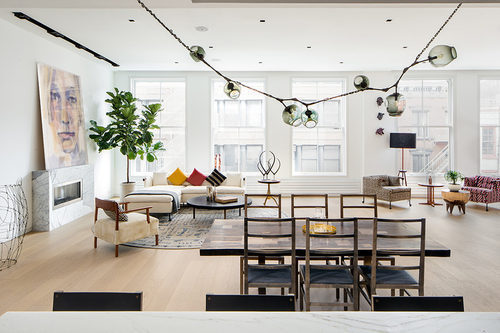
Even a quick glance at 52 Lispenard from the outside reveals the presence of many large windows. And once you’re inside one of the building’s units, it’s easy to see all the different ways that the interior space was inspired by the presence of lots of natural light.
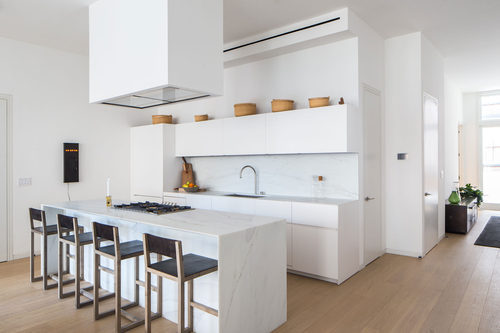
Some of the wonderful features found in each residence include white oak plank floors, fireplaces, LED lighting, smart home pre-wiring, a 4-zone heating & cooling system, auxiliary radiant heat and a highly functional laundry room.
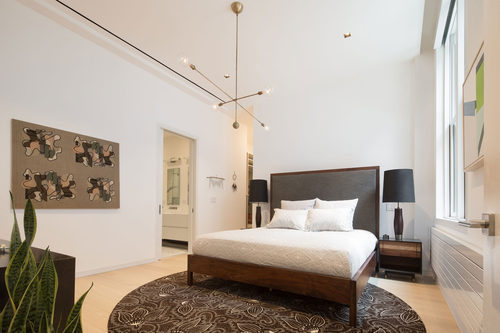
In the kitchen, residents can enjoy preparing food on the marble countertops, as well as using the top of the line Gaggenau appliances. Master bathrooms feature Calacatta marble on the walls and floors, a steam shower and radiant heated floor. Secondary bathrooms offer custom vanities, as well as lovely limestone wall tiles.
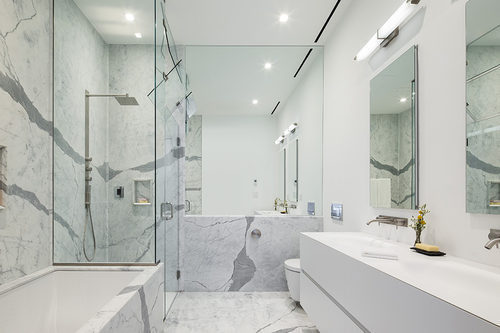
Availability
The official 52 Lispenard website currently has two of the seven units listed as available. Unit 4 is a 5 bedroom and 4.5 bathroom space with a total of 3,432 square feet. The significant amount of space inside Unit 4 is complemented by 91 square feet of exterior space. The asking price for this unit is $6.65 million.
Unit 2 is the other unit that’s currently available. It has 4 bedrooms and 4.5 bathrooms. The ample space in Unit 2 comes to a total of 3,804 square feet. The asking price for this residence is $7.5 million.
Neighborhood
Since 52 Lispenard offers large spaces that can truly be called home, it’s only fitting that this address is located in such a great neighborhood. Not only does Tribeca offer a lot of rich history, but it puts everything from gourmet groceries to excellent dining and culture within walking distance.
[ 52 Lispenard ]
The post 52 Lispenard appeared first on | Elika Real Estate.
March 13, 2015
Neighborhood Spotlight: Park Slope, Brooklyn
What’s the big attraction to living in Park Slope? Surely this northwest Brooklyn neighborhood’s denizens keep a running list of the many reasons why the Slope is one of the city’s most desirable areas. Because of its proximity to Prospect Park, highly rated public schools, and small-town feel, more and more families are choosing to hang their hats in Park Slope.
The Neighborhood
Park Slope’s borders lie at Prospect Park and Prospect Park West to the east, Fourth Avenue to the west, Flatbush Avenue to the north, and Prospect Expressway to the south. The neighborhood is broken down into three distinct sections –– North Slope (from Flatbush Avenue to Garfield Place), South Slope (south of 10th Street), and Center Slope (1st through 9th Streets).
Lined with brownstones and apartments throughout, Park Slope boasts majestic Queen Anne and Romanesque Revival homes throughout the Historic District, which lies along the west end of Prospect Park. Residents claim that the once Bohemian neighborhood is easygoing and a comfortable place to live. Even if you’re passing through, you’ll notice the laid-back attitude of Brooklynites who inhabit the neighborhood.

Things to do
In addition to all that Prospect Park has to offer, Park Slope is home to the Brooklyn Academy of Music, the Brooklyn Museum, the Brooklyn Botanic Garden, as well as a thriving dining, nightlife, and shopping scene.

Shop on the “other” Fifth Avenue at spots like Bird for upscale fashion, Annie’s Blue Ribbon General Store for one-of-a-kind gift ideas, and O Live Brooklyn, an olive oil and vinegar emporium.
Eat short rib hash for brunch at Stone Park Café, and check out Piccoli Trattoria, Blue Ribbon, or Al Di La for dinner. Park Slope has its share of watering holes too. Favorites include Pacific Standard and Union Hall –– both are awesome spots for an after-work brew or a late-night cocktail.

Transportation
The area is well served by public transit, which provides easy access to Manhattan. Even if certain subway lines undergo construction or maintenance on weekends, you won’t be without other options.
The D, M N/R stops at Pacific Street, and the 2/3 stops at Atlantic Avenue, Grand Army Plaza, and Bergen Street. The 4/5 stops at Atlantic Avenue while the B and Q trains stop at Atlantic Avenue and Seventh Avenue. The M and R go to Union Street and 9th Street. Pick up the F at Fourth Avenue, 9th Street, Seventh Avenue, or at 15th Street/Prospect Park.

What it costs
Park Slope is one of Kings County’s wealthiest neighborhoods and one of the most sought after in all of New York City. Inventory is low, and prices are high. Although located in Brooklyn, the cost of real estate is comparable to Manhattan.
Don’t be surprised when you see listings in the $500K to $700K range for a one-bedroom apartment. And if you’re in the market for a house, townhomes start in the $3 million range. Depending on the size, condition, and original details, the larger, more elaborate brownstones can cost above $6 million.
The post Neighborhood Spotlight: Park Slope, Brooklyn appeared first on | Elika Real Estate.





